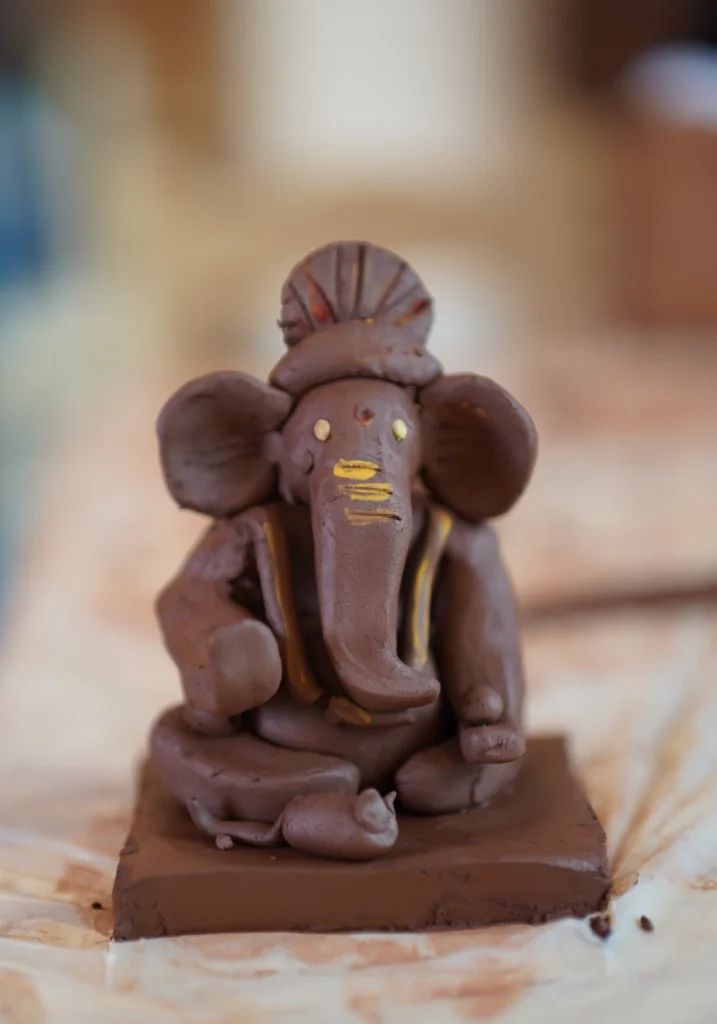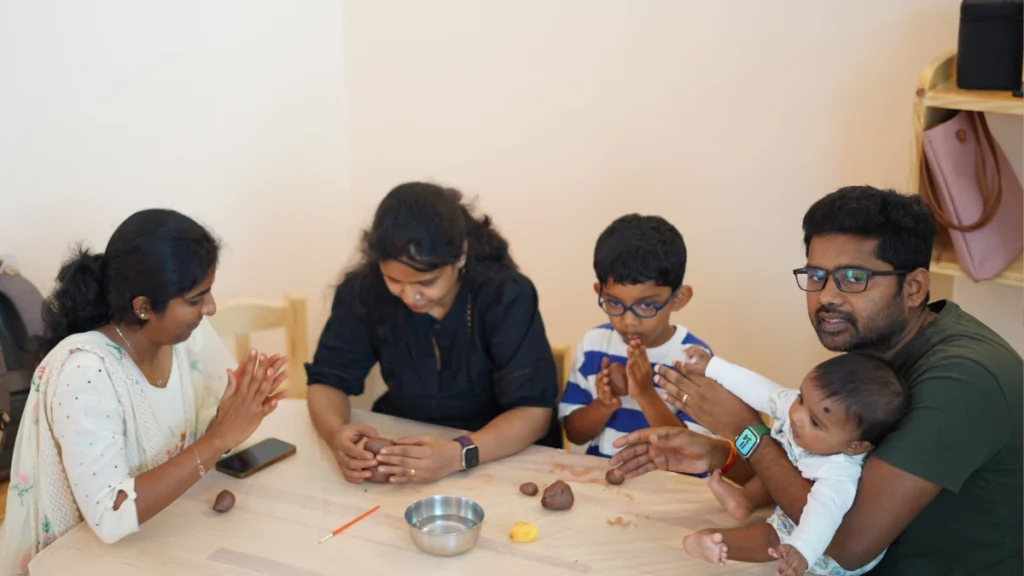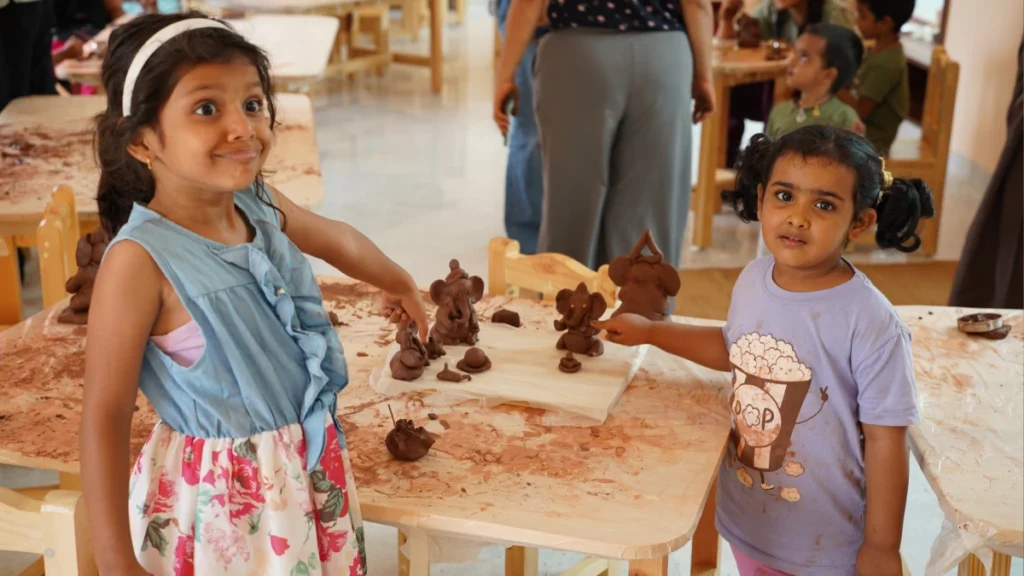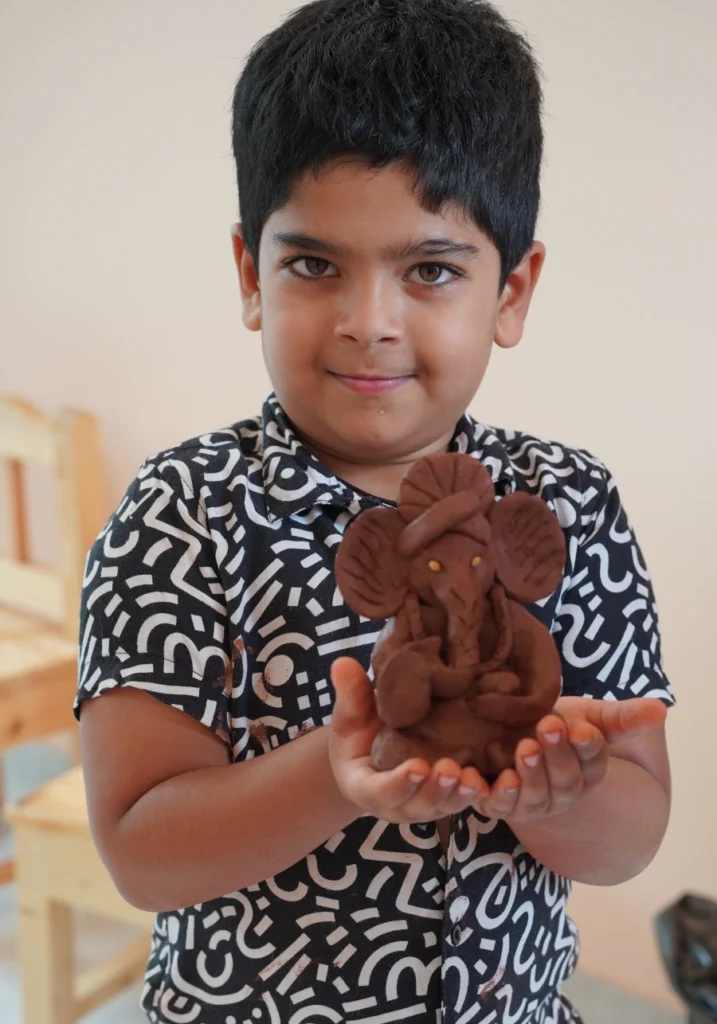Festivals are memories we carry of the food we savour, the songs that linger, the stories we share, and the joy of being together. They are impressions and recollections woven into the fabric of childhood. At Thraya, our Clay Ganesha making event was created to bring these exact moments alive,where children and parents sang, listened, moulded, tasted, and created with joy.
Singing with rhythm and joy
The celebration opened with songs that children could truly engage in melody and imitate in gestures. These songs carried the fragrance of flowers, the taste of sweets, the laughter of children, and the rhythm of drums. They were not mere performances, but experiences that allowed each child to step into the festival fully. With each line echoing joy, they sang in Telugu, in Hindi, and in English, with verses simple enough to hold filled with meaning.

Thondam paade jaaji raagam
Navvulu chindhe merise dhantam
Undrallu panche theepi aanandam
Bojjalo ninde paalu bellam
Adugulu vese gajamela gaanam
Eluka iche chinnari sneham
తొండం పాడె జాజి రాగం
నవ్వులు చింధె మెరిసె ధంతం
ఉండ్రాళ్లు పంచె తీపి ఆనందం
భొజ్జలొ నిండె పాలు బెల్లం
అడుగులు వేసే గజమెల గానం
ఎలుక ఇచ్చే చిన్నారి స్నెహం
Big round ears, so wide, so wide
They listen to the whispers, side to side
A little trunk wiggles, up and down
It reaches and it tickles, all around
Soft kind eyes that shine so bright
They twinkle like the stars at night
A round full tummy, warm and sweet
It loves good fruit and tasty meals
Stepping and stomping, slow and strong
Walking and walking, all day long
A little rat runs by his side
Together they go, a joyful ride!
Little Ganesha, so gentle and true
We walk and we sing, our love to you.
गणपति बप्पा आए, आए,
ढोल बजे सब गाए, गाए।
नाचो-गाओ, हाथ मिलाओ,
मिलकर सब खुशियाँ मनाओ।
फूल खिले रंग-बिरंगे,
लड्डू मोदक कितने प्यारे।
नाचो-गाओ, हाथ मिलाओ,
मिलकर सब खुशियाँ मनाओ।
बच्चे हँसे, झूमें, गाए,
तालियाँ सब मिल बजाए।
नाचो-गाओ, हाथ मिलाओ,
मिलकर सब खुशियाँ मनाओ।
Ganpati Bappa aaye, aaye,
Dhol baje sab gaaye, gaaye.
Naacho-gaao, haath milao,
Milkar sab khushiyaan manao.
Phool khile rang-birange,
Laddu modak kitne pyaare.
Naacho-gaao, haath milao,
Milkar sab khushiyaan manao.
Bacche hanse, jhoome, gaaye,
Taliyaan sab mil bajaaye.
Naacho-gaao, haath milao,
Milkar sab khushiyaan manao.
Clay alive in little hands

As they set the rhythm in song and movement, soon enough the little hands transitioned to reach for clay. The reddish-brown, raw earthy terracotta rested in palms, inviting touch and imagination. Children pressed, rolled, and shaped, discovering how clay can transform into a figure. Some Ganeshas had wide ears, others round bellies, each one unique. Parents joined, guiding softly, while leaving room for the child’s own imagination.
Tastes that connect to celebration
Food offered during festivals carries more than flavor. They are symbols of abundance, of nature’s gifts gathered in season, and of the warmth of sharing. In childhood, these tastes linger in sweetness and strength woven into memory, grounding the festival in both body and heart. A handful of dates were pitted and blended into a paste. Almonds, cashews, sesame seeds lightly roasted and ground to a powder. A spoon of roasted sooji (semolina) and a splash of milk — binding it all together to make ladoos that children and parents savoured in joy.
Story that lives on

Stories during festivals weave meaning into celebration, carrying the wisdom of the past into the listening hearts of children. Long after the words are spoken, the story continues to live within, shaping imagination and reverence for the world around. Gathered close, the children listened to the story of The Little Elephant Child.
Once upon a time, in a land filled with golden sunshine and whispering trees, there lived a kind Mother who loved to create. With her hands, she shaped dolls, little birds, and tiny animals, bringing joy wherever she went.
One day, as the warm breeze rustled around her, she took soft clay in her hands and began to shape something new. Slowly, gently, she formed a small child. She gave him round cheeks, twinkling eyes, and a sweet little smile. With love so deep, she whispered, “You are my child.” And just like that—the little one was alive!
This child was unlike any other. He had the head of a gentle elephant, with big ears that could hear even the quietest songs of the forest, and a curved little trunk that wiggled happily. He was strong, but also kind. He was curious, but also wise.
The Mother smiled and said, “You are special. You will bring peace wherever you go. Your ears will listen to those who need to be heard. Your trunk will help those who need a hand. And your heart will always be full of joy.”
The little Elephant Child—Ganesha—loved to play. He rolled fruit along the garden path, he splashed in the river, and he sat under the great trees listening to the birds. Wherever he went, children and animals followed, for they knew he was gentle and good.
One day, the stars whispered to one another: “This little one will be the helper of new beginnings. Wherever a journey starts, wherever a new path is made, he will be there, smiling, making sure it goes well.”
And so it was. Whenever people built a new home, started a story, or began a journey, they remembered the little Elephant Child. They told his story, and they smiled, knowing he would walk beside them with his quiet strength and kind heart.
And if you listen carefully, even now, you might hear him—his ears catching the softest sounds of joy and sorrow, his trunk reaching out to lend a hand, his laughter rolling like thunderclouds that bring rain.
A festival of memory and belonging

By the end, the room was filled with clay Ganeshas—different, imperfect, and beautiful. Songs still lingered. The taste of ladoos remained. The story of the Elephant Child lived in the children’s hearts.
Festivals at Thraya are woven not for spectacle, but for memory. They preserve the senses, nurture imagination, and give children a rhythm of belonging.








